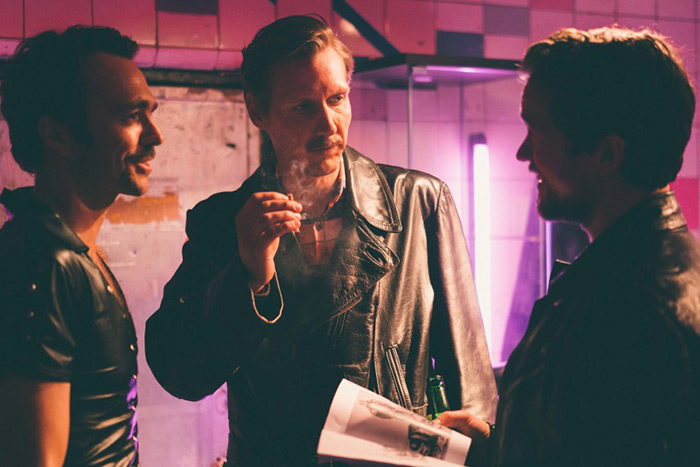Danny Peary Talks to... 'Tom of Finland' Director and Cast

Surely since the beginning of the sexual revolution in America in the 1970s, almost every adult has come across the bold, ultra-masculine, ground-breaking homoerotic fetish art of Finnish illustrator Touko Laaksonen (1920-1991), better known as Tom of Finland. But unless you’ve taken a tour of the Tom of Finland House in the Echo Park section of Los Angeles or attended recent exhibitions of his work in Berlin, it’s unlikely that you know his entire story.
There’s no better way to learn about this iconic LGBT pioneer than to see Finnish director Dome Karukosi’s faithful, heartfelt, and splendidly acted Tom of Finland. The film opens this Friday in New York at the Quad on West 13th Street, and next Friday in L.A., Berkeley and San Francisco, before having a multi-city release. Also, this Sunday it will play at the in Huntington. It is Finland’s official submission to the Oscars in 2018.
The synopsis: “Touko Laaksonen (Pekka Strang), a decorated officer returns home to live with his sister Kaija (Jessica Grabowsky) after a harrowing and heroic experience serving his country in World War II. But life in Finland during peacetime proves equally distressing. He finds postwar Helsinki rampant with homophobic persecution….Touko finds refuge in his liberating art: homoerotic drawings of muscular men, free of inhibitions. But it is only when an American [Seumas Sargent as Doug] sees them, has them published, and invites Touko to visit the West Coast that his life early takes a turn. Finally able to walk free and proud in Los Angeles, Touko dives head first into the sexual revolution, becoming an icon and a rallying point.”
Karukosi’s Director’s Statement: “This is the story of a man ahead of his time, bravely standing up against a world virulently against his right to be who he was—a homosexual man with homosexual fantasies. Story shows how literally one person can create change in the world even with something as simple as an artist’s tools….Touko Laaksonen truly lived an incredible life worth sharing with the world.”
The trailer:
In April, during the Tribeca Film Festival, I was able to have the following conversation about Tom of Finland with Dome Karukosi (a rising star who is slated to direct a biopic of J.R.R. Tolkien), and his enthusiastic cast members, Pekka Strang, Jessica Grabowsky and Seumas Sargent.

Danny Peary: I was looking at Wikipedia this morning and was actually surprised that Touko Laaksonen—Tom of Finland—was listed among the famous people who are from Finland. Did you always know about him?
Dome Karukoski: When I was a boy, from 12 to 14, someone in our “gang” found or stole one of his comic books from somewhere. And we were giggling, thinking someone from America had visited Finland and been inspired by something here and had taken “Tom of Finland” as his alias. We didn’t really know he was Finnish until his death a couple of years later, in 1991. Even after, in the nineties, there was a silent period about him because it was still illegal to promote gay material in Finland.
Pekka Strang: Until 1999.
DK: Yes. Homosexuality was decriminalized in 1971 but it was considered a sickness until 1981, and the law against the promotion of gay material—the same law they have in Russia now—lasted until 1999. So Tom of Finland’s art couldn’t be made visible until then. In the new millennium we could see his material slowly popping up in Finland.
PS: There are actually two parts to him: the Tom of Finland brand and the artist behind the images. I never knew anything about the artist. I think that’s the case with most people in Finland—they know only the brand. We’re starting to be proud of the brand but we’re still asking, “Who was the artist behind it?” That’s what this movie is about.
DP: When you say “brand,” is that mostly fashion and homoerotic products?
PS: All kinds of things, even coffee.
Jessica Grabowsky: The stamps were a huge thing. I was working in Sweden when they were issued, and people were asking me, “Can you get me those stamps, please?” That was one of the first things with the Tom of Holland brand.
DP: That was in 2014 and I think that was the first time there was erotic imagery on stamps.
PS: It wasn’t the most hardcore, of course.
DK: However, there was an image of a man’s ass, so there was the funny idea of you licking a man’s ass when you put that stamp on an envelope. So there was a double entendre! That stamp was bought all over the world, in over 150 countries. It was probably the stamp that sold out quickest in Finnish postal history. They did a test of its popularity by sending seven packages of Tom of Finland stamps into Russia. Five arrived and what happened to the other two is still a mystery.
DP: Pekka, did Dome tell you about Touka, or did you have time to do research?
PS: When I was called for casting, I started to read about him and learned about him being in the war. And I met a few of his friends. The problem was that Tom died in 1991 so those people were quite old and knew him just in the seventies and eighties. So we didn’t have first-hand material from the forties, fifties and sixties. Still, meeting his friends was helpful in my making an interpretation of who he was.
DP: Did the people you talked to think of him as someone they loved or someone who was strange or something else?
PS: It was like this: He was funny, he was really nice, he was a beloved uncle, he was good at work, he was a good soldier. He was successful at everything he did. What I was told by Durk Dehner of the Tom of Finland Foundation in Los Angeles was: “You must understand that Tom was a Nordic god.” I said, “Okay.”
DP: It’s interesting that Tom of Finland’s road to fame started in California, when Doug, Seumas’s character, started promoting his art and getting it published, and it became huge in the homosexual community there, particularly in Los Angeles and San Francisco.
DK: We had to keep the film tight and not have too many characters, so we combined a few and altered their names. The character of Doug is actually the combination of two real people. The young Doug is taken from one person and the older Doug is taken from Durk Dehner.
Seumas Sargent: And I play Doug. It was a late casting process for me.
JG: It was like two days before!
SS: Right, so I didn’t really have time to do research, and it was a little disarming knowing I was going to be playing a living person who I wanted to give respect. I had the pleasure of meeting the real Doug—Durk—at our premiere in Helsinki. I turned around and we recognized each other. I said, “I hope I did you justice,” and he gave me a big hug. That was quite rewarding.
DP: I am curious about Durk Dehner’s foundation, which is located in the two-story house where Tom lived and worked in Echo Park in L.A, beginning in the seventies. Does it have a large amount of Tom of Finland material in addition to the illustrations?
DK: From the time we started doing research for this film in 2011, the foundation provided us with the most help in formulating his character and all the characters around him. Once we secured the licensing rights to the art in 2015, we started our collaboration with the foundation and it opened its archives to us. Over the years, it had collected all of Tom’s letters, the photographs he took, and the photographs taken of him. Having never met him in person, it was important for us to learn about him from stories and anecdotes we came across, from the people who knew him. That really generated the character in the film.
DP: Did he write an autobiography or are there good biographies about him?
DK: There are a couple of books about him and a couple that he was involved in, based on interviews. And also there is a documentary in which he is interviewed, but that was in 1991 so it was the older version of Tom. As Petta said, the difficulty we had was finding the 20 and 30-year-old Tom, and we found that in the letters and the subjects he was interested in photographing. There is an interesting history. Tom was ill for a long time and he was afraid that if his art remained in Finland, it would be destroyed. So he started smuggling his work—all that is in Tom House in Echo Park—out of the country during his visits to Los Angeles. He didn’t trust his family or his sister to preserve it. In the film, Tom and Kaija have a love/hate relationship and she was upset by his art.

DP: So he really cared about his legacy.
DK: As most artists do.
DP: Jessica, what is Kaija’s role in the movie, her function in the script?
JG: Maybe her role is to mirror the thoughts of that time, to show that even someone who loves Tom doesn’t appreciate his art.
DP: To me she also represents good, regular people who still can’t move over to his side.
JG: You have to put her in context of a time when his homoerotic art was illegal in Finland.
PS: Also, she represents the silence regarding such art and other things that weren’t talked about in Finland. Just like don’t ask, don’t tell.
SS: There’s acknowledgment and denial and more acknowledgment and denial, and so much built-up tension in the relationship between Tom and Kaija.
JG: I don’t think it’s just denial. It’s also protection because Tom is her brother and she loves him a great deal. She wants what is best for him and thinks he’s safer if he doesn’t exhibit that kind of art.
DK: Again, in Finland, homosexuality was considered a sickness then, so people like Kaija assumed Tom and other homosexuals could heal and become heterosexual. I was always touched by the story of Kaija. There are all these pictures of her with Tom and Veli [his lover played by Lauri Tilkanen] when they traveled in Germany and became like a threesome. Then Kaija denied Tom’s art. Two times. Once when he was living, when she told him that he wasn’t allowed to use their name Laaksonen or have exhibitions in Finland—Durk was actually present at that meeting. And when Durk called Kaija in 2006 to congratulate her because her brother’s art had been accepted by MOMA—and she said, “What are they thinking?”
DP: There is a scene in the movie in which Tom says that it is not a matter of being cured. Do you think Touko realized on his own when he was a teenager that homosexuality was not a sickness?
PS: He was actually younger. He was 10 years old when he started looking at lumberjacks and bus drivers. I don’t think he thought he was doing anything wrong. He never had that crisis with himself. But of course, he understood society so he lived a double life to protect his family from scandal. That’s at least what I learned.
DP: I’d think that he was in the minority among gay men at that time in thinking that there was no cure and that it was okay.
PS: I can’t claim with certainty that I’m correct, but I believe it’s a true picture of his philosophy in life. If you look at his illustrations, you see men who are proud and happy and enjoying each other. He couldn’t not acknowledge being gay and do those drawings. He drew them at night and they were his fantasies and his utopia.
DP: Dome, there is such structure to this film—and Tom’s life—that my guess is that when you were working with your scriptwriter, Aleksi Bardy, you were you setting up the story as Section 1, Section 2, Section 3, etc.?
DK: We did, thank you for noticing. We divided it into five segments. We were trying to find time spans of about five years each, but we couldn’t because his transformation as a character and his transformation as an artist and his influence happened during each of four decades. So we had to have all four decades in the film. So we divided the film into five sections that we felt were important emotionally to Tom and started building the script from that. We came up with the segments based on listening to him in his interviews. The war, the first section, was obviously important. You see the influence of uniforms on his art. Everything that happened during the war stayed with him until the end of his life, and I think he experienced several “wars,” including the AIDS war. I say that because it must have felt to him like he was again waging war against an enemy and young men were dying around him.
DP: The section of the film that takes place after World War II is extremely tense. You film both Tom’s smuggling of his art by train into Germany and his homosexual hookups—with people meeting clandestinely and the vigilante police looking to arrest them—almost as if you were making an espionage movie. Was that your intention?
DK: I believe that he felt that time in his life was like that. He was smuggling his art on trains and he had to photograph it so it was small enough to fit into a small envelope and look like a letter. A big envelope would arouse suspicion. He had to think up ways of doing things without being arrested and his actions inspired the thriller element in the movie. I could have done a whole movie about that alone.
DP: If viewers just saw that scene where he is being interrogated, they’d think he was possibly a spy, as he was accused of being by German authorities, rather than an artist trying to smuggle his own homoerotic art. Because according to the laws, they were both serious crimes.
DK: It was a different era and there were laws in place against homosexuality dating back to the Nazis. He was actually interrogated for three days about being a spy. It was Berlin, Cold War, Tom was trying to acquire a passport.
DP: Seumas, do you think Doug is totally altruistic about promoting Tom’s art, or is he also thinking about making money?
SS: I think he has a completely altruistic standpoint. He loves the art and is fascinated by the idea of these leaked publications. He becomes pen pals with Tom and a pivotal moment is when he brings the art into California. In the film’s portrayal of the gay guys at the pool with Doug, you see how free we can actually be in this setting as opposed to the dark undercurrent of suspicion and threat the pervades the first part of the film that Tom is in. Doug takes this whole trip from publisher to publisher to get Tom’s art published so it can be seen, to the point where he comes to Z in the alphabet. He wouldn’t do that if it was just about making money. So I would say, yeah, he’s completely altruistic.
DK: Durk, the real-life person, has committed his life to Tom’s art. As in the film, he wrote Tom and invited him to come to California and he arranged the first exhibitions in New York and San Francisco. After that he became Tom’s partner and manager and later on the head of the Tom of Finland Foundation. So he dedicated his whole life to Tom and his art. Tom, of course, is his biggest inspiration.
DP: How much of what you have in the film was true about the art being published by the last house Doug came to and it being a small Jewish house?
DK: At a time even liberals in L.A. were accusing Tom of promoting the sex that was causing the AIDS epidemic, Moishe was saying, “Of course, I’ll publish him, no problem.” All the crazy things in the film with Moishe, his daughter Hava, and even the bunny that is smuggled into the hospital and escapes and causes chaos really happened!
DP: Tom of Finland’s art is always super-masculine, with huge, muscular bodies and leather, so was he ever criticized by gays who didn’t see themselves as that way?
DK: For a time, Tom was not cool with everyone. You often hear heterosexuals stupidly ask, “What do gays think?” as if all gays are of one type. Tom’s depicting hyper-masculinity was liberating for many gays. They thought, “Yes, I can be like that.” For instance, a high school quarterback might tell himself, “I can’t be gay because all gays are feminine,” but Tom’s art told him, “I am allowed to be gay and be the way I am. I can put my leather jacket on and move to Los Angeles.” Of course, it caused a counter-response during that time. Now I think the LGBT community sees his art as a good thing.
JG: I think at first there was criticism because gays felt pressure to look like the men in Tom’s art and wear black leather.
SS: If those people who are aware of Tom only for being a slightly pornographic artist actually saw his real artwork with uber-masculine superhero figures, they’d realize that it’s a stand-alone, exceptional genre of art. It isn’t just semi-pornographic images in a magazine that you flip through, but something that is truly substantial and remarkable. The stamps, the coffee—the artwork is fascinating and not just because it’s sexual and risqué. When I saw the original art for the first time is was when it really hit me what I was doing and what the movie is about. That art is outstandingly good.
DP: Pekka, what do you admire most about Tom?
PS: His courage. He was 21 when he was fighting in the war and seeing people die around him, and after that experience his focus on life is different from our own today. He realized after that, that life can end at any point and there is no reason to be afraid anymore.
DP: Jessica, Kaija is peripheral to Tom’s story and it could be told with Kaija being just a minor player because we never see her life outside of her relationship with him. But it’s your strong performance that makes her a major character. Were you ever afraid that she would get lost in the movie?
JG: I didn’t think about that. I was afraid that she’d be kind of black-and-white and just be the bitch that everyone would hate. That was my main focus.
DK: I will confirm that we were so focused on building Tom’s character that Kaija was a black-and-white character in the script. What you see in the film is very much different because Jessica came along and we started talking about and rebuilding the character. It is very much due to her that her character has such substance.
DP: What is the importance of Tom of Finland coming out now, in 2017?
PS: I know they’d been planning it for years and were supposed to shoot it earlier when I wasn’t involved, so I’m happy it took so long. The world has changed a lot. There is the rise of conservative and nationalistic movements, so it’s really important to tell our history so we never go back to that time. With all respect to the United States, there are some bad things happening here also. So I’m hopeful that we can bring some humanity to the world. The most positive reaction by the LGBT community in Finland to the movie is the realization that this is probably our first movie in which the lead character is gay but it isn’t an issue. I’ve read several columns about how we have a gay lead character and audiences don’t question his sexuality.
DP: That’s because he doesn’t.
PS: He doesn’t. We tried to focus on that.
SS: This movie is a gift. I told Dome that as an actor you don’t often engage to this extent with the work that you do. There are wonderful moments, but they’re often fleeting. This is a project all of us are so wholeheartedly invested in because it has clout, it has weight, it is so significant. So being part of this movie and being with it at Tribeca, apropos the times we are living in, is a gift.
DP: And what about getting Touko’s name out there?
DK: I think he’d be really proud. He would accept any way of getting his art out there. Any coffee, any stamp, any movie. He wouldn’t want to be in the spotlight and stand in front of people talking into a microphone—the rumor is that they had to drug him to get him to do that because he was so nervous—but he’d be very happy to get his art out there at this time in history. Without shame. Without fear. And as a way to fight oppression.
Danny Peary has published 25 books on film and sports, including Cult Movies and Jackie Robinson in Quotes.









